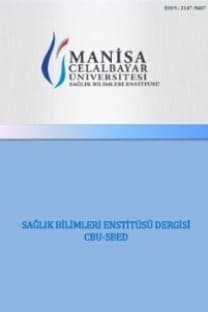Torakolomber Vertebra KırıklarındaPosterior Stabilizasyon Uygulanan Hastalarımızda Geç Dönem Sonuçlarımız
Late Results of Posterior Stabilization in Patients with Thoracolumbar Vertebral Fractures
___
- 1. Yılmaz G, Acaroğlu E, Torakolomber bölge omurga yaralanmaları, Türkiye Klinikleri Journal of Surgical Medical Sciences, 2006, 2(30), 5-10.
- 2. White, A.A, Panjabi, M.M, Clinical biomechanics of the spine, 2nd Edition Lippincott Williams & Wilkins, Philadelphia, 1990, pp: 115- 117.
- 3. Benli, İ.T, Tandoğan, N.R, Kış, M, Tüzüner, M, Mumcu, E.F, Akalın S, Çıtak M, Cotrel –Dubousset instrumentation in the treatment of unstable thoracic and lumbar spine fractures, Archives Orthopaedic Trauma Surgery, 1994, 113, 88 – 92.
- 4. Eastlack, R.K, Bono, C.M, Fractures anddislocations of the thoracolumbar spine, In: RW, Heckman, J.D, Court-Brown, C.M, (Eds.), Rockwood and Green’s Fractures in Adults, Vol. 2, 5th Edition., Lippincott Williams Wilkins,Philadelphia, 2001, 1543- 1580.
- 5. Knop, C, Fabian, H, Bastian, L, Blauth, M, Late results of thoracolumbar fractures after posterior instrumentation and transpedicular bone grafting, Spine, 2001, 26 (1), 88-89.
- 6. Marco, R.A, Kushwaha, V.P, Thoracolumbar burstfractures treated with posterior decompression and pedicle screw instrumentationsupplemented with balloon – assisted vertebroplasty and calcium phosphate reconstruction, Journal of Bone and Joint Surgery, 2009, 91 – A(1), 20 – 28.
- 7. McLain, R.F, Burkus, J.K, Benson, D.R, Segmental instrumentation for thoracic and thoracolumbar fractures: prospective analysis constructs survival and five – year follow, Spine, 2001, 1 (5), 310 – 323.
- 8. Scholl, B.M, Theiss, S.M, Kirkpatrick, J.S, Short segment fixation of thoracolumbar burst fractures, Orthopaedics, 2006, 29 (8), 703 –708.
- 9. Vaccaro, A.R, Kim, D.H, Brodke, D.S, Harris, M, Chapman, J, Schildhauer, T, Routt, M.L.C, Sasso, R.C, Diagnosis and Management of Thoracolumbar Spine Fractures. An Instructional Course Lecture, American Academy of Orthopaedic Surgeons, Journal of Bone and Joint Surgery American, volume 2003, 85-A, 2455-70.
- 10. Zdeblick, T.A, Sasso, R.C, Vaccaro, A.R, Chapman, J.R, Harris, M.B, Surgical treatment of thoracolumbar fractures, Instructional Course Lectures, 2009, 58, 639 – 644.
- 11. Roy-Camille, R, Saillant, G, Mazel, C, Plating of Thoracic, Thoracolumbar and Lumbar Injuries with Pedicle Screw Plates, Orthopedic Clinics of North America, 17, 147–159, 1986
- 12. Gertzbein SD, Court-Brown CM, Marks P, et al, (1988) The neurologic outcome following surgery for spinal fractures, Spine 13, 641–4.
- 13. Cotler, J.M, Vernace, J.V, Michalski, J.A, The use of Harrington rods in thoracolumbar fractures, Orthopedic Clinics of North America, 1986, 17, 87-103.
- 14. Dickson, J.H, Harrington, P.R, Erwin, W.D, Results of reduction and stabilization of the severely fractured thoracic and lumbar spine, Journal of Bone and Joint Surgery,1978, 60-A, 799-805.
- 15. Ebelke, D.K, Asher, M.A, Neft, J.R, Kraker, D.P, Survivorship Analysis of VSP Spine Instrumentation in the Treatment of Thoracolumbar and Lumbar Burst Fractures, Spine, 16, 428–432, 1991.
- 16. Graziano, G.P, Cotrel-Dubousset hook and rod combinations for spine fractures, Journal of Spinal Disorders, 6, 380-385, 1993.
- 17. Alvine, G.F, Swain, J.M, Asher, M.A et al, (2004) Treatment of thoracolumbarburst fractures with variable screw placement or Isola instrumentation and arthrodesis: case series and literature review, Journal of Spinal Disorder Techniques,17(4), 251 –64.
- 18. McLain, R.F, Sparling, E, Benson, D.R, 1993, Early failure of short segment pedicle instrumentation of thoracolumbar fractures, A preliminary report, The Journal of Bone and Joint Surgery, 75(2):162–7.
- 19. Weinstein, J.N, Collalto, P, Lehmann, T.R, Thoracolumbar “burst” fractures treated conservatively: a long-term follow-up, Spine, 1988, 13, 33-38.
- 20. Denis, F, Armstrong, G.W, Searls, K, Matta, L, Acute thoracolumbar burst fractures in the absence of neuralgic defisit, A comparison between operative and non-operative treatment, Clinical Orthopedics and Related Research, 1984, 189; 1-9.
- 21. Shen, W.J, Liv T.J, Shen, Y.S, Non operative treatment versus posterior fixation for thoracolumbar junction burst fractures without neurologic defisit, Spine, 2001, 26 (9), 1038 –1045.
- 22. Saifuddin, A, MRI of acute spinal trauma, Skeletal Radiology, 2001, 30, 237-246.
- 23. Yazar, T, Acar, B, Yatay konumlu konvansiyonel MRG’de aksiyel kompresyon ve traksiyon uygulaması omurga değerlendirimesi için anlamlı mıdır? The Journal of Turkish Spinal Surgery, 2009, 20 (4), 11-18.
- 24. Knop, C, Fabian, H, Bastian, L, Blauth, M, Late results of thoracolumbar fractures after posterior instrumentation and transpedicular bone grafting, Spine, 2001, 26(1), 88-89.
- 25. McNamara, M.J, Stephens, G.C, Spengler, D.M, Transpedicular short-segment fusions for treatment of lumbar burst fractures, Journal of Spinal Disorders, 1992, 5(2), 183-187.
- ISSN: 2147-9607
- Yayın Aralığı: Yılda 4 Sayı
- Başlangıç: 2014
- Yayıncı: Manisa Celal Bayar Üniversitesi Sağlık Bilimleri Enstitüsü
Tanısız Lokal Organize Pnömonilerin Akciğer Rezeksiyonları İçindeki Oranı Nedir?
Sevinç YAŞAR CAN, Behiye DİLMEN BAYAR
Nonsendromik İşitme Kayıplı Olgularda GJB2 Mutasyon Dağılımı
TAHİR ATİK, Bilcağ AKGÜN, Esra IŞIK, Ferda OZKINAY
Akut İskemik İnmeli Hastalarda, İnmenin Ciddiyeti İle Monosit/HDL-K Arasındaki İlişki
Mide Kanseri’nde Erken Tanı Hayat Kurtarır
“Kanıta Dayalı Hemşirelik”: Hemşirelik Öğrencilerinin Bilgi, Tutum ve Davranışları
ASLI KALKIM, Tülay Sağkal MİDİLLİ
Melek MEMOĞLU, Songül ÖZYURT, Neslihan ÖZÇELİK, Aziz GÜMÜŞ, Ünal ŞAHİN
Önlisans Öğrencilerinin Depresyon ve Gündüz Uykululuk Düzeyi Bakımından İncelenmesi
Aysun YAĞCI ŞENTÜRK, Elif OKUR
Davranış Bağımlılığı ve Sosyal Hizmet Uygulamaları Üzerine Bir İnceleme
Melek ZUBAROĞLU YANARDAĞ, Mehmet, Umut YANARDAĞ
Türkiye'nin Leishmaniasis Araştırmalarına Katkısı (1980-2019): Bibliyometrik Analiz
